Robotic Milkers Revolutionizing Dairy Farming
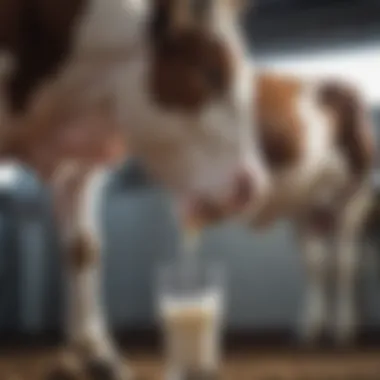
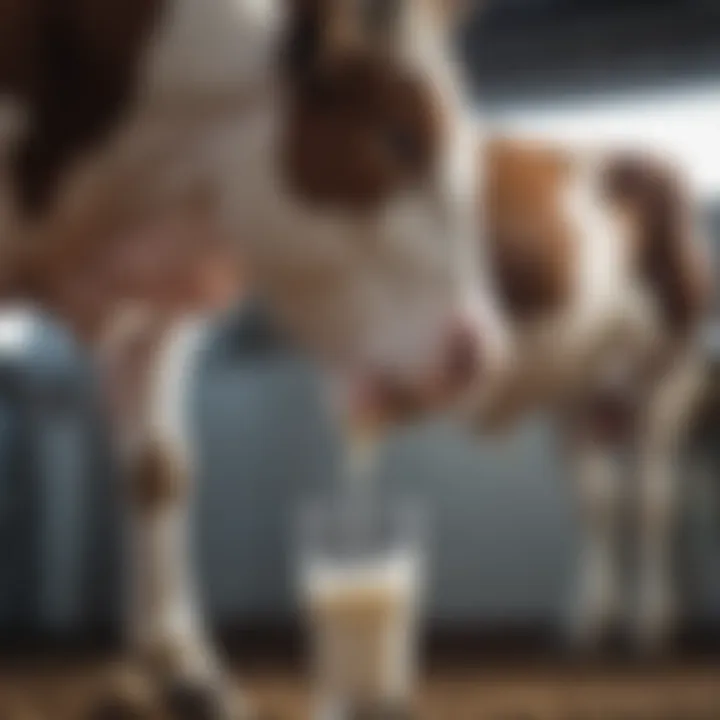
Key Concepts and Terminology
Basic Definitions
Robotic milkers are automated systems designed to extract milk from cows without the need for manual labor. These systems are equipped with sensors, computer controls, and robotic arms that mimic the actions of human farmworkers. The primary purpose of robotic milking is to streamline the milking process, improving efficiency and reducing the labor requirements across dairy farms.
Historical Context
The existing technology for robotic milkers began development in the late 20th century. Early prototypes emerged in Europe, with the first commercial installations appearing in the 1990s. These systems have undergone constant improvement, incorporating advanced technology to enhance usability and efficiency.
Recent Innovations and Trends
Technological Advancements
In recent years, many innovations have transformed robotic milking systems. Improvements in artificial intelligence allow for better monitoring and analysis of cow behavior. Furthermore, enhanced sensors provide more accurate data regarding milk quality and cow health. Integration with farm management software allows for real-time tracking of various metrics, making it easier for farmers to make informed decisions.
Sustainable Practices
Robotic milking systems also promote sustainable practices. They help optimize labor, reduce waste, and limit environmental impacts. By decreasing dependency on human labor, farms can also mitigate potential issues related to worker shortages. Robotic milking supports the goals of sustainability in dairy farming by promoting efficiency and minimizing resource consumption.
Practical Applications and Techniques
Step-by-step Guides
Farmers interested in implementing robotic milking should consider several key steps:
- Evaluate Dairy Farm Needs: Understand the specific requirements of the farm and herd size.
- Research Systems: Assess different robotic milking systems available on the market.
- Consult Experts: Engage with technology providers for tailored recommendations.
- Plan Implementation: Develop a timeline for installation and integration.
- Train Staff: Ensure that farm personnel are familiar with the new technology.
Case Studies
Several farms have successfully integrated robotic milking systems into their operations. For instance, a case study from a dairy farm in Wisconsin showcases increased milk production and improved herd health following the adoption of robotic milkers. Data indicated a notable reduction in stress for the cows, leading to a more productive milking environment.
Robotic milking systems represent a step forward in modernizing dairy farming, making it more efficient and sustainable, while improving animal welfare.
Foreword to Robotic Milking Systems
Robotic milking systems are increasing in significance, reshaping the landscape of dairy farming. These systems represent a shift toward innovation, enhancing farm efficiency and animal welfare. This introduction provides a comprehensive overview of robotic milking's definitions, history, and implications for modern agriculture.
Definition and Overview
Robotic milking systems, often referred to as automatic milking systems (AMS), are advanced technological solutions for extracting milk from cows. Unlike traditional milking methods, which typically require substantial human involvement, robotic systems automate the process. Cows enter the milking units voluntarily, where sensors and robotic arms perform the milking. This approach allows producers to optimize milking frequency, resulting in potential boosts in milk yield. It's crucial to note that the success of these systems lies in their ability to provide regular milking, which aligns with the natural behavior of cows. This method not only supports an increase in productivity but also focuses on minimizing stress for the animals.
Historical Context of Milking Practices
Milking practices have evolved significantly over the centuries. Initially, milking was a manual process, requiring considerable time and labor. Farmers used their hands, leading to variable outcomes in terms of efficiency and yield. The introduction of milking machines in the early 20th century marked a primary shift towards mechanization. These machines improved efficiency but still required human oversight.
As technology advanced, the development of robotic systems began in the late 20th century. Early prototypes were experimental and limited in their capabilities. However, by the early 21st century, advancements in sensors, automation, and data management led to the introduction of the first commercially viable robotic milking systems. This progression reflects a broader trend in agriculture towards automation, aiming to reduce labor costs and improve production efficiencies. The melding of engineering and animal husbandry creates an environment where farmers can focus more on overarching farm management and less on daily repetitive tasks.
Technological Components of Robotic Milkers
The integration of advanced technology into dairy farming is a critical development in enhancing efficiency and productivity. Robotic milkers employ several sophisticated technological components that enable them to function effectively within the complex environment of dairy operations. Understanding these components is essential for farmers looking to invest in or upgrade to robotic milking systems. Each technological element contributes significantly to the overall functionality, economic viability, and improvement of animal welfare.
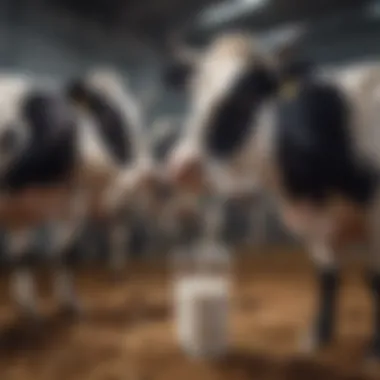
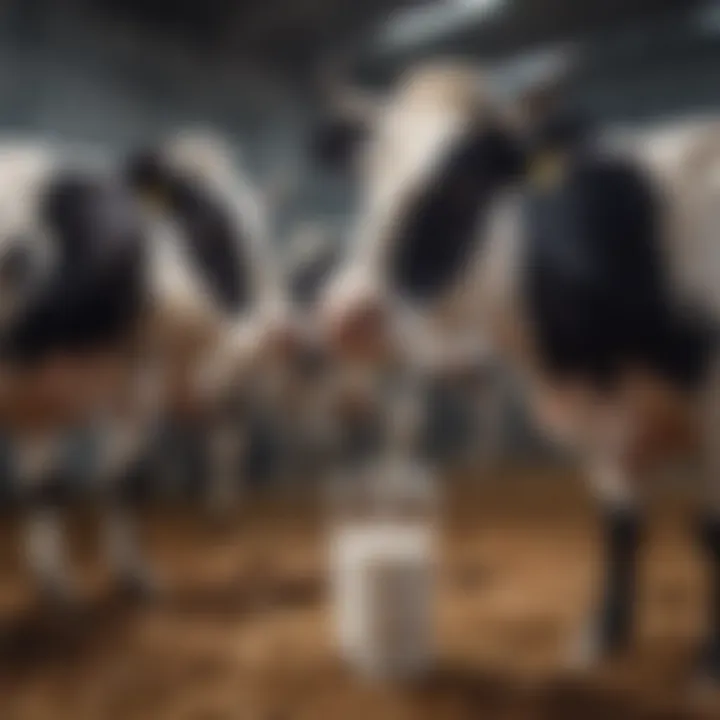
Sensors and Automation
Sensors play a vital role in robotic milkers. They are utilized for a variety of functions, including measuring the cow's milk output, detecting the cow's udder, and ensuring the proper attachment of the milking machine. Automation simplifies the milking process, freeing up time for farmers. The automation of routine tasks offers consistent milking schedules that align with each cow's natural rhythms. This not only enhances efficiency but also minimizes stress for the animals.
Milk Collection Systems
Milk collection systems in robotic milkers are designed for both efficiency and hygiene. These systems collect milk directly from the cow's udder, ensuring minimal handling and contamination. Modern robots use vacuum systems that are actively managed for optimal effectiveness. Ensuring the right pressure during milking is crucial. Proper milk collection impacts the quality of the milk and the overall productivity of the dairy farm.
Data Management and Analysis
In the age of digital farming, data management becomes a cornerstone of modern dairy production. Robotic milkers collect vast amounts of data that can enhance decision-making processes. Information ranging from individual cow performance to milking times is useful for farmers aiming to improve their business operations.
Real-time Monitoring
Real-time monitoring is a key characteristic of robotic milking systems. It allows farmers to observe the status of each cow while milking occurs. This immediate data collection leads to faster responses to any issues that arise, improving overall herd management. For example, if a cow's milking time exceeds the average, the system alerts the farmer for inspection. This capability not only aids in efficiency but supports animal welfare by promptly identifying health issues.
Analysis of Milk Quality
The analysis of milk quality is essential for both economic and health reasons. Robotic milking systems can assess the quality of milk in real-time. Parameters such as fat content, somatic cell count, and bacterial levels can be monitored. This helps in maintaining high standards needed for market requirements. Consistent monitoring allows farmers to detect abnormalities early, which protects the herd's health and the business's profitability. However, there is a need for proper calibration of the systems to ensure accurate readings, as errors could lead to poor decision-making.
Animal Health Records
Maintaining animal health records is vital in modern dairy farming. Robotic milkers automatically track health parameters during the milking process. This offers detailed insights into each cow's health status, helping farmers to manage their herd effectively. The digital records assist in detecting patterns or anomalies in milk production, which could indicate health issues. While this technology presents enhanced monitoring capabilities, it also relies on training farm staff to interpret data correctly, ensuring that the insights are actionable.
Advantages of Robotic Milkers
The advent of robotic milkers marks a significant transformation in dairy farming. These systems introduce various advantages that can enhance operational efficiency, increase productivity, and promote better animal welfare. Understanding these advantages is crucial for farmers and stakeholders aiming to optimize their practices in a competitive market. Robotic milking not only reshapes farm management but also aligns with the current trends in sustainable agriculture.
Labor Efficiency
One of the primary advantages of robotic milkers is their ability to streamline labor in dairy operations. Traditional milking methods often require a substantial workforce, which can be both costly and challenging to manage. Robotic milkers automate the milking process, allowing fewer workers to operate a larger herd. This transition frees up human resources, enabling staff to engage in other essential tasks on the farm that demand more skill or oversight.
The reduction in labor hours directly correlates to lower operational costs. Farmers can allocate funds previously spent on hiring additional staff to invest in technology or improve other aspects of the farm. Furthermore, with robotic systems, milking can occur at any time of day, permitting flexible work schedules that align better with farm rhythms and animal needs.
"The integration of robotic systems has changed how we view labor management in dairy farming, making it more efficient."
Increased Milk Yield
Robotic milkers contribute significantly to increased milk yield. These systems provide a consistent environment for cows, ensuring they are milked at optimal times. Cows often have specific milking preferences, which robotic technology can respect and accommodate. By allowing cows to enter the milking station as they see fit, these systems can enhance cow comfort, leading to increased milk production.
Also, robotic systems can perform frequent milking, allowing cows to be milked multiple times a day. Studies have shown that increased milking frequency can positively impact overall milk yield, as cows tend to respond well to the regular removal of milk. Consequently, farms that adopt these robotic systems may see significant increases in their production levels, leading to higher returns.
Improved Animal Welfare
The implementation of robotic milkers also plays a pivotal role in enhancing animal welfare. These systems are designed with animal comfort in mind, minimizing stress during the milking process. The gentle nature of robotic milkers, combined with the ability for cows to choose when to be milked, contributes to a less stressful environment for the animals.
Healthier cows are more productive. Additionally, improved monitoring through integrated sensors allows farmers to gather data on individual cow health. This real-time data can signal any potential health issues early, enabling prompt interventions. The focus on animal well-being is becoming more important as consumers increasingly demand humane farming practices and higher quality products. Organic farming trends and market preferences are likely to favor operations that emphasize animal welfare alongside productivity.
Challenges and Considerations
The integration of robotic milkers into dairy farming presents various challenges and considerations that farmers must navigate. Understanding these challenges is crucial for farmers looking to adopt this technology, as it influences not only the decision-making process but also the long-term viability of their operations. This section focuses on these complexities, diving deep into specific elements that can impact the efficiency of robotic milking systems.
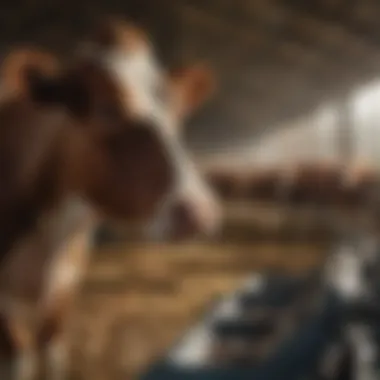
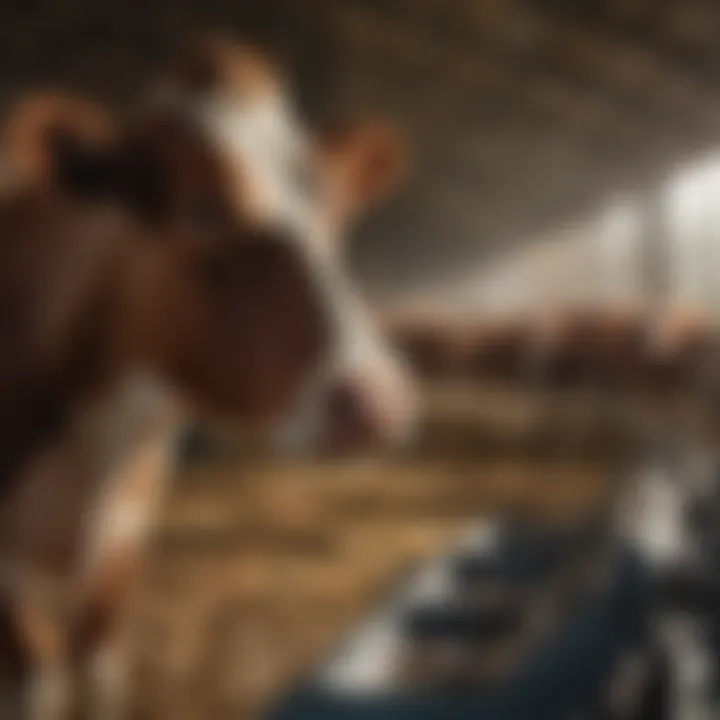
High Initial Investment Costs
One of the most significant barriers to adopting robotic milkers is the high initial investment required. The cost of purchasing and installing these systems can be substantial, sometimes exceeding hundreds of thousands of dollars. This is a considerable financial commitment, especially for smaller farms.
Farmers must evaluate not only the purchase price but also ongoing service costs. Regular maintenance and potential software updates can add to the overall expense. Many farmers find that financing options help, but it still requires careful financial planning.
A careful cost-benefit analysis is essential. Comparing the upfront costs against long-term savings in labor and potential increases in milk production can provide clearer insight. If managed well, this investment can lead to improvements in efficiency and productivity over time, justifying the initial expenditures.
Technical Issues and Maintenance
Robotic milking systems are complex pieces of machinery. As such, they can experience technical issues that require immediate attention. Problems may include software glitches, hardware malfunctions, or sensor failures.
Farmers must be prepared to deal with such issues promptly. Failing to do so can lead to production downtime and potential financial losses. Establishing a relationship with reliable service providers is essential. Regular preventive maintenance can help minimize unexpected breakdowns, ensuring the system operates smoothly.
Additionally, troubleshooting can be challenging for farmers not trained in advanced technology. This pushes the need for ongoing support and maintenance planning.
Training and Skill Development
Another crucial concern is the need for training and skill development for farm workers. Operating robotic milkers requires a different skill set compared to traditional milking methods. Employees must understand how to manage and monitor the systems effectively.
Providing adequate training is essential to maximize the benefits of robotic milking. This may include understanding system functionality, diagnosing basic issues, and utilizing data analytics from the system. Furthermore, there may be a learning curve involved, which can initially disrupt everyday operations.
Farmers should consider investing in training programs to enhance their team's capabilities. Additionally, continuous learning opportunities will help staff adapt as technology evolves. Ensuring that staff feels confident when working with advanced milking technologies can significantly impact farm productivity and reduce operational challenges.
"Investing in training not only supports the operational readiness of robotic systems but also boosts employee morale and job satisfaction."
In summary, while the adoption of robotic milkers offers numerous benefits, careful consideration of these challenges is vital for a successful transition. Understanding the financial implications, technical requirements, and training needs will help ensure farmers can leverage the full potential of robotic milking technology.
Impact on Dairy Farming Practices
The advent of robotic milkers has transformed dairy farming, influencing various management practices and the larger agricultural landscape. The integration of such technology is not merely an upgrade in toolsets; it represents a paradigm shift that redefines traditional methodologies. With enhanced automation and real-time data acquisition, farmers experience significant changes in how they manage their herds and operations.
Shifts in Farm Management
Robotic milkers require a rethinking of farm management strategies. Dairy farmers need to adapt to new workflows that incorporate technology efficiently. This includes setting specific routines for cattle and ensuring that the farm layout facilitates robotic operation. Regular monitoring and adjustments become essential. Farmers often have to focus more on data analysis than on manual milking tasks.
- Benefits include:
- Reduced labor requirements for milking.
- More time for strategic farm management tasks.
- Ability to track individual cow performance over time, leading to refined breeding and feeding strategies.
However, the shift also demands that farmers invest time in understanding the technology. As farmers become accustomed to these robotic systems, they gain insights into herd health and production metrics that were previously difficult to manage. Such insights can lead to better decision-making and overall improvements in farm productivity.
Integration with Sustainable Practices
Sustainability is at the core of modern agricultural practices. Robotic milkers can enhance these efforts through several avenues. The precision they offer in monitoring each cow allows for tailored feeding programs. This reduces waste and improves milk output per feed unit. Additionally, the systems often include features that address manure management, contributing to better waste recycling processes.
- Key sustainable impacts include:
- Improved feed efficiency due to precise monitoring.
- Reduced environmental footprints by lowering resource consumption.
- Enhanced animal welfare leading to healthier cows and better milk quality.
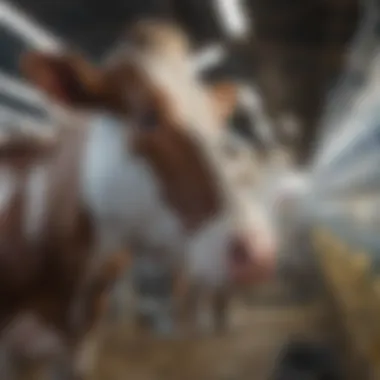
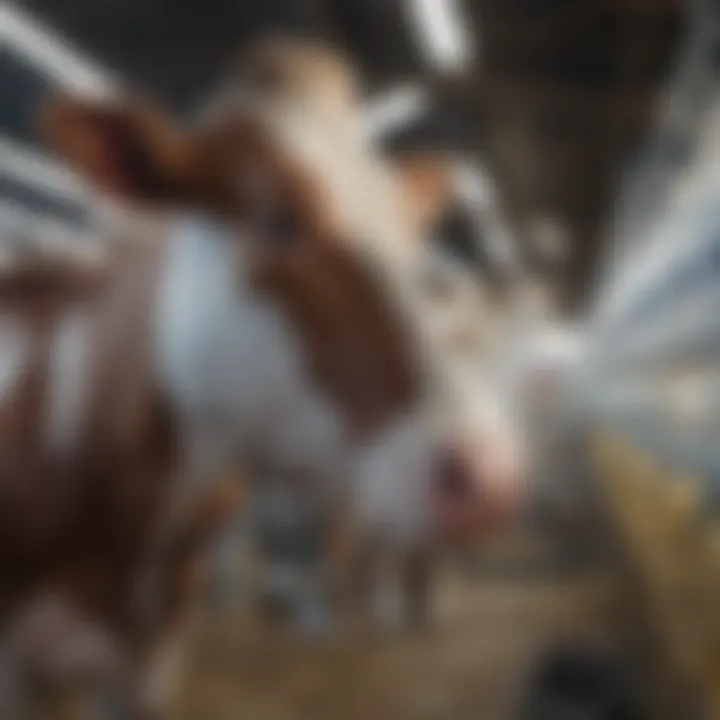
As sustainability becomes a priority for consumers and regulatory bodies alike, integrating robotic milkers supports farms in meeting these expectations while also improving their economic viability.
Consumer Preference and Market Trends
The consumer landscape is increasingly shaped by awareness regarding animal treatment and sustainable farming practices. Robotic milkers can enhance transparency and efficiency in dairy production, addressing these consumer concerns effectively. A shift towards animal welfare and sustainability is evident, and robotic systems help facilitate this shift by promoting humane treatment and reducing stress in cows.
- Notable market trends include:
- Growing demand for sustainably-produced dairy products.
- Increased consumer interest in the welfare of farm animals.
- Shift towards products that guarantee traceability from farm to table.
Farmers employing robotic milkers can leverage these trends to their advantage, capturing a segment of the market that values responsible farming practices. This creates opportunities for brands to differentiate through quality and commitment to animal welfare, ultimately influencing consumer purchase behaviors.
"Robotic milking systems not only boost productivity but also align with the evolving consumer expectations regarding ethical farming and sustainability."
Future of Robotic Milking Technology
The future of robotic milking technology promises to reshape the landscape of dairy farming. Understanding the potential of these technologies is critical for farmers and stakeholders looking to enhance productivity and sustainability. As automation becomes more integrated into agricultural practices, robotic milkers are expected to evolve significantly, offering various benefits. Key elements include innovations that can improve efficiency, global impacts on the dairy industry, and the vital regulatory considerations that need to be addressed for widespread implementation.
Innovations on the Horizon
Advancements in technology consistently push the boundaries of what robotic milkers can achieve. This includes improved sensor technologies which ensure better monitoring of cow health and milk quality. Developments in artificial intelligence will enable these systems to learn from data patterns, helping farmers make more informed decisions regarding herd management.
Furthermore, we expect innovations in user interfaces, making it easier for farmers to interact with the system. These changes can lead to solutions that not only automate milking but also provide analytics about each cow’s performance, facilitating targeted interventions.
As a result, these innovations could result in increased milk yields and enhanced animal welfare, driving the dairy industry towards smarter practices.
Potential Global Impact
The implications of robotic milking technology extend far beyond individual farms. On a global scale, the adoption of these technologies has the potential to improve food security by increasing milk production efficiency. Countries facing labor shortages or aiming to enhance their dairy industries may see rapid adoption of robotic milking systems.
Additionally, as the demand for sustainable practices grows, robotic milkers allow farms to reduce their carbon footprint by optimizing resource use. This transformation not only benefits farmers but also aligns with consumer preferences for ethically sourced products. Importantly, these systems could provide vital data to support further research into dairy farming optimization and sustainability efforts.
Regulatory Considerations
As robotic milking becomes more prevalent, various regulatory considerations will also come into play. The agricultural sector has to navigate complex regulations regarding animal welfare and food safety. Manufacturers of robotic milking technology must ensure that their products meet these regulations to be viable in the market.
Beyond just compliance with existing laws, there is a need for the development of new policies that reflect the advancements in this technology. Regulators may need to engage with farmers and technology developers to create frameworks that support innovation while safeguarding public health and animal welfare.
As the technology advances, it is essential to consider how regulations can adapt to protect both the industry's future and its stakeholders effectively.
"The application of innovative technologies has the potential to change traditional dairy farming into a more efficient and sustainable practice."
Closure
The conclusion of this article on robotic milkers is an essential component that encapsulates the key findings surrounding modern dairy farming technology. It serves multiple purposes. First, it synthesizes the information presented throughout the sections, allowing readers to grasp the overall significance of robotic milking systems in the contemporary agricultural landscape.
Summary of Key Points
Robotic milking technology significantly enhances dairy farm productivity, providing solutions to many traditional milking challenges. Key points include:
- Technological Advancement: Modern robotic systems are equipped with advanced sensors and automation capabilities that improve efficiency.
- Labor Efficiency: Automation reduces the need for manual labor, allowing farmers to redirect resources toward other essential farm operations.
- Animal Welfare: By allowing cows to choose their milking times, robotic systems contribute positively to animal health and welfare.
- Challenges: Initial investment, technical maintenance, and training must be managed for successful implementation.
- Future Impact: Ongoing innovations hint at a promising future, where robotic milkers may become integral to sustainable dairy farming practices.
Final Thoughts on Robotic Milking
The advancement of robotic milking systems underscores a significant shift in dairy farming. These systems not only address labor shortages but also prioritize animal welfare, aligning with modern agricultural standards. As the industry evolves, it is imperative for farmers and agronomists to stay informed about these technologies. Awareness can lead to better decision-making regarding investments in robotics, ultimately influencing productivity and sustainability in dairy farming.
Robotic milkers have the potential to revolutionize milk production globally, and understanding both their benefits and challenges is essential for current and future dairy agricultural practices. For those considering the adoption of robotic milking systems, the insights provided in this article serve as a valuable guide.















